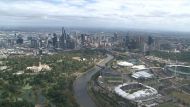An imminent tightening of security at Parliament House threatens to deny public access to its signature sloping lawns, as authorities worry about the iconic building's ongoing vulnerability to a terrorist attack.
The restriction of access to the upper lawns - which has been pushed by security agencies in the past but never eventuated on heritage grounds - could alter the nature of the giant complex, which was designed to allow the people of Australia to walk over the heads of their elected representatives.
More National News Videos
MPs divided over Canberra fence
The days of kids rolling down the manicured lawns of Parliament House may soon be over under a new security proposal.
While details of the proposed upgrade are being tightly held, Fairfax Media understands a number of changes have already received the support of the major parties in the House of Representatives and will be progressed with senators this week, with a view to works beginning over summer.
New reinforcements are believed to include the installation of security barriers across areas currently accessible to the public, the erection of fencing and gates around the Senate and House of Representatives entries, fewer pedestrian entry points, and additional machine gun-equipped police patrolling its perimeters.

This measure would augment the existing x-ray and metal detector screening points within the buildings, which some experts have warned can only detect threats and intercept would-be terrorists who had already made it inside.
Other changes are said to include new private screening rooms and redesigned layouts and controls within current visitor and employee screening areas.
The measures would be in addition to the $110 million already spent on Parliament House security upgrades since 2014, when "chatter" about an attack on the building was intercepted by the government.
A previous attempt by security agencies to have a large fence block access to the sloping roof at the rear of the building was blocked on heritage grounds, however sources said the latest measures are likely to include restricted access to grassed areas towards the top of Parliament House, leaving only small areas at the bottom for public recreation.

A 2015 document prepared by the Department of Parliamentary Services noted security agencies wanted fencing to block the public from climbing the building's rear grass ramps. The department rejected that on heritage grounds but noted "security agency advice was unequivocal that a fence for that part of the precinct was absolutely vital to provide an appropriate security layer".
Senate President Stephen Parry has briefed the opposition and crossbenchers about the upgrades at special meetings in Canberra over the past fortnight.

Discussion are ongoing, however his office would not comment on Monday.
The planned changes are the latest in a series of measures enacted in recent years, which have seen the ministerial entrance fortified by a 2.6 metre fence and the installation of bullet-proof windows and charge-resistant shields.

Access to certain areas inside the building has been progressively restricted, prompting complaints that executive government was shielding itself behind security on the pretence of safety when other motives might be in play, like keeping press gallery journalists away.
The architect of Parliament House, Romaldo Giurgola, described the most recent changes as "offensive" and warned they would change the democratic character of the building. Mr Giurgola died in May.

Australia's National Terrorism Threat Advisory System is currently set at "probable" - one level below "expected" and two levels below "certain".
This means there is "credible intelligence, indicating that "individuals or groups continue to possess the intent and capability to conduct a terrorist attack in Australia".
Officials have long conceded that the parliamentary complex is a high value target for terrorists. It is the workplace of the nation's 226 federal politicians when Parliament is sitting, as well as thousands of senior bureaucrats, journalists, and parliamentary officers.
Former prime minister Tony Abbott revealed in 2014 the building was a fresh target for a terrorist attack.
"We've seen in other countries that have been more terrorism-prone for longer than Australia attacks on parliaments and other government buildings and we want to ensure that no-one is tempted by a lack of security to take on a target such as this," he said.














24 comments
New User? Sign up